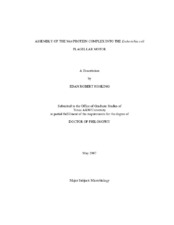| dc.contributor.advisor | Manson, Michael D. | |
| dc.creator | Hosking, Edan Robert | |
| dc.date.accessioned | 2007-09-17T19:42:04Z | |
| dc.date.available | 2007-09-17T19:42:04Z | |
| dc.date.created | 2003-05 | |
| dc.date.issued | 2007-09-17 | |
| dc.identifier.uri | https://hdl.handle.net/1969.1/6017 | |
| dc.description.abstract | The MotA and MotB proteins of E. coli form a MotA4MotB2 complex. Proton flow through a transmembrane channel in the complex powers flagellar rotation. Protonation of Asp-32 of MotB within the channel is proposed to cause a conformational change in the large cytoplasmic loop of MotA, which pushes against FliG in the rotor. MotB is believed to anchor the complex to the cell wall via a conserved sequence that is found in many proteins that bind peptidoglycan. The research presented in this dissertation focused primarily on the formation and activation of the MotAB proton channel. A proposed amphipathic α-helical region, extending from residue 52 through 65 of the periplasmic domain of MotB, was discovered to block proton flow through the channel in its inactive state prior to incorporation into a flagellar motor. The plug is thought to lie parallel to the periplasmic face of the cell membrane and to be removed from the membrane by a conformational change triggered by contact with the motor. Negatively charged residues near the cytoplasmic C-terminus of MotA and positively charged residues at the cytoplasmic N-terminus of MotB were identified as being important for motility. A mutational analysis and subsequent suppressor analysis suggest that these residues may align MotA and MotB to form the MotA4MotB2 complex in the proper position relative to FliG and the rotor. The underlying mechanism for producing MotA and MotB in a 2:1 ratio was also investigated and found to be primarily due to translational coupling of motA and motB. The stop codon of motA and the start codon of motB overlap, allowing the ribosome that has just completed translation of motA to reinitiate and translate motB. The efficiency of reinitiation is about 66%; presumably degradation of excess MotB not in the MotA4MotB2 complex produces the final 2:1 ratio. Research was also conducted to determine whether MotB binds directly to the peptidoglycan layer of the cell wall. Although inconclusive, the preliminary results appear to support this notion. The overall work provides insights into several aspects of the assembly and subsequent activation of the stator component of the bacterial flagellar motor. | en |
| dc.format.extent | 44863607 bytes | en |
| dc.format.medium | electronic | en |
| dc.format.mimetype | application/pdf | |
| dc.language.iso | en_US | |
| dc.publisher | Texas A&M University | |
| dc.subject | MotAB | en |
| dc.subject | proton channel | en |
| dc.title | Assembly of the Mot protein complex into the Escherichia coli flagellar motor | en |
| dc.type | Book | en |
| dc.type | Thesis | en |
| thesis.degree.department | Biology | en |
| thesis.degree.discipline | Microbiology | en |
| thesis.degree.grantor | Texas A&M University | en |
| thesis.degree.name | Doctor of Philosophy | en |
| thesis.degree.level | Doctoral | en |
| dc.contributor.committeeMember | Golden, Susan | |
| dc.contributor.committeeMember | Johnson, Arthur | |
| dc.contributor.committeeMember | Young, Ryland | |
| dc.type.genre | Electronic Dissertation | en |
| dc.type.material | text | en |
| dc.format.digitalOrigin | born digital | en |


